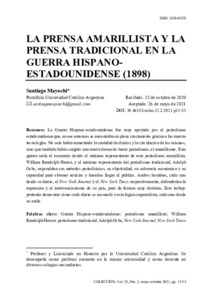Por favor, use este identificador para citar o enlazar este ítem:
https://repositorio.uca.edu.ar/handle/123456789/12604| Campo DC | Valor | Lengua/Idioma |
|---|---|---|
| dc.contributor.author | Mayochi, Santiago | es |
| dc.coverage.temporal | SIGLO XIX | es |
| dc.date.accessioned | 2021-10-28T11:52:36Z | - |
| dc.date.available | 2021-10-28T11:52:36Z | - |
| dc.date.issued | 2021 | - |
| dc.identifier.citation | Mayochi, S. La prensa amarillista y la prensa tradicional en la guerra hispano-estadounidense (1898) [en línea]. Colección. 2021, 32 (2). doi: 10.46553/colec.32.2.2021.p13-53. Disponible en: https://repositorio.uca.edu.ar/handle/123456789/12604 | es |
| dc.identifier.issn | 1850-003X (en línea) | - |
| dc.identifier.issn | 0328-7998 (impreso) | - |
| dc.identifier.uri | https://repositorio.uca.edu.ar/handle/123456789/12604 | - |
| dc.description.abstract | Resumen: La Guerra Hispano-estadounidense fue muy apoyada por el periodismo estadounidense que, en ese entonces se encontraba en pleno crecimiento gracias a las nuevas tecnologías. No solo había aumentado la cantidad de diarios y la circulación de los mismos, sino que también había surgido una nueva forma de hacer periodismo, el amarillismo. Esta guerra sería el escenario donde el máximo representante de este periodismo amarillista, William Randolph Hearst, y el máximo representante del periodismo tradicional, Adolph Ochs, expondrían sus métodos periodísticos, su objetividad, su solvencia económica y su capacidad para obtener noticias y hacerlas llegar al público. Ambos hombres, cada uno desde su diario, el New York Journal y el New York Times respectivamente, defenderían la expansión y el intervencionismo de su país, pero de formas muy distintas. Este trabajo pretende demostrar cómo cada diario se acomodó a esta lógica imperialista, cada uno desde su estilo. | es |
| dc.description.abstract | Abstract: The Spanish-American War was very supported by the American journalism which by then was growing thanks to the new technologies. Not only the amount of newspapers and its circulation had augmented, there was also a new way to do journalism, the yellow press. This war would be the scenario were the mayor exponent of the yellow press, William Randolph Hearst, and the mayor exponent of the traditional press, Adolph Ochs, would expose their methods, their objectivity, their economic solvency and their capability to obtain the news and deliver them to the public. Both men, each one from their own newspaper, the New York Journal and The New York Times, defended the expansion of their country, but in very different ways. This paper’s objective is to demonstrate how each newspaper manage the imperial logic in their own way. | es |
| dc.format | application/pdf | es |
| dc.language.iso | spa | es |
| dc.publisher | Pontificia Universidad Católica Argentina. Facultad de Ciencias Sociales. Departamento de Ciencias Políticas y Relaciones Internacionales | es |
| dc.rights | Acceso abierto | * |
| dc.rights.uri | http://creativecommons.org/licenses/by-nc-sa/4.0/ | * |
| dc.source | Colección. 2021, 32 (2) | es |
| dc.subject | GUERRA HISPANO-ESTADOUNIDENSE | es |
| dc.subject | PERIODISMO | es |
| dc.subject | PRENSA | es |
| dc.subject | SENSACIONALISMO | es |
| dc.subject | TRADICIONALISMO | es |
| dc.subject | New York Times | es |
| dc.subject | New York Journal | es |
| dc.subject | POLITICA EXTERIOR | es |
| dc.title | La prensa amarillista y la prensa tradicional en la guerra hispano-estadounidense (1898) | es |
| dc.type | Artículo | es |
| dc.identifier.doi | 10.46553/colec.32.2.2021.p13-53 | - |
| uca.disciplina | CIENCIA POLITICA | es |
| uca.issnrd | 1 | es |
| uca.affiliation | Fil: Mayochi, Santiago. Pontificia Universidad Católica Argentina; Argentina | es |
| uca.version | publishedVersion | es |
| item.fulltext | With Fulltext | - |
| item.languageiso639-1 | es | - |
| item.grantfulltext | open | - |
| Aparece en las colecciones: | COL - 2021 Año XXVI nro. 32-2 | |
Ficheros en este ítem:
| Fichero | Descripción | Tamaño | Formato | |
|---|---|---|---|---|
| prensa-amarillista-prensa-tradicional.pdf | 2,16 MB | Adobe PDF |  Visualizar/Abrir |
Visualizaciones de página(s)
1.331
comprobado en 27-abr-2024
Descarga(s)
2.536
comprobado en 27-abr-2024
Google ScholarTM
Ver en Google Scholar
Altmetric
Altmetric
Este ítem está sujeto a una Licencia Creative Commons

